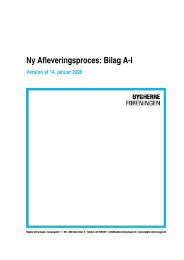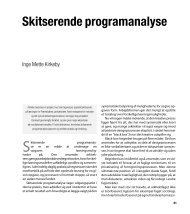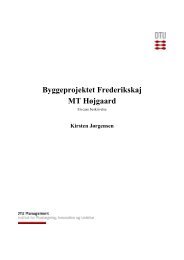Udvælgelses- dan og tildelingskriter ske byggesektor ... - RenProces
Udvælgelses- dan og tildelingskriter ske byggesektor ... - RenProces
Udvælgelses- dan og tildelingskriter ske byggesektor ... - RenProces
You also want an ePaper? Increase the reach of your titles
YUMPU automatically turns print PDFs into web optimized ePapers that Google loves.
The figure and the persons mentioned in the figure can be changed over time. The figure<br />
illustrates, through the project there is at any time one and only one person who takes all the<br />
final decisions. All other team members are at the same level but subordinate to the project<br />
manager at any time. All members have to discuss the decisions and have to find solutions.<br />
Only if the team cannot agree the project manager can use his veto.<br />
Even if it is the client or the project manager who is the most important, it is very central to<br />
decide who the top manager of the project is. It is him/her who has to make a decision about<br />
how the organization chart shall look and has to find out the number of seats in the team,<br />
what the ideal personality profile is of each member and what personal and technical<br />
competencies are required from each team member.<br />
The project manager must be as close as posible to either match the required personal<br />
compentencies, technical compentencies, the personality of the owner or be good at<br />
cooperating with the owner and others. The most important for the project manager is<br />
interpersonal competencies as being good at managing, planning, coaching and doing<br />
strategies. (Soeholm and Storch, 2005)<br />
When the project manager is found the next decision has to be taken; who on the next level is<br />
the most important person? The architect, one of the engineers, the turnkey contractor or one<br />
of the subcontractors? This can differ from project to project and also from client to client.<br />
But it is important that the decission is made before persons are chosen. The reason is that the<br />
manager probably lacks some competencies compared to the ideal manager, and maybe he<br />
has compentencies that are not needed for the manager but for other team members. Then the<br />
deficiencies will be looked for when finding the next person.<br />
When finding the next person the same procedure will be used. The most ideal person for the<br />
place on the project will be employed as described by the client; the ideal person also has<br />
competencies which are not required by the client, but which will be very useful in the<br />
teamwork. Again, a person only near to the ideal is probably found. The deficiencies will be<br />
listed and the same procedure will be repeated for the following team members.<br />
Finally, maybe with addition of a bit of luck, a building team has been chosen as close to the<br />
ideal as possible, hopefully with only few deficiencies. The building team has to be able to<br />
work with the deficiencies, but if the project has an almost ideal team with all the personal<br />
competencies, technical competencies, personalities, abilities to cooperate etc. then the<br />
building team is likely to succeed, which is better than what takes place in a big part of the<br />
building sector today.<br />
The above described way of building a project team is different from what has been the<br />
procedure until now in Denmark. From the interviews we learned that companies like to do<br />
things as usual. It is an easy way and it is difficult to blame anyone when things go wrong, if<br />
a person has just done the work in a usual way for the building sector.<br />
Since the new Tendering Law from 2001 came into force more projects occur which use<br />
other things than costs as selection and assignment criteria. Therefore it seems to become<br />
more acceptable to use other criteria. But one problem is that compared to the Danish<br />
Tendering Law and to the European tendering legislation every criterion can be used; that is,<br />
if the chosen criteria are measurable and unambiguous.<br />
211










